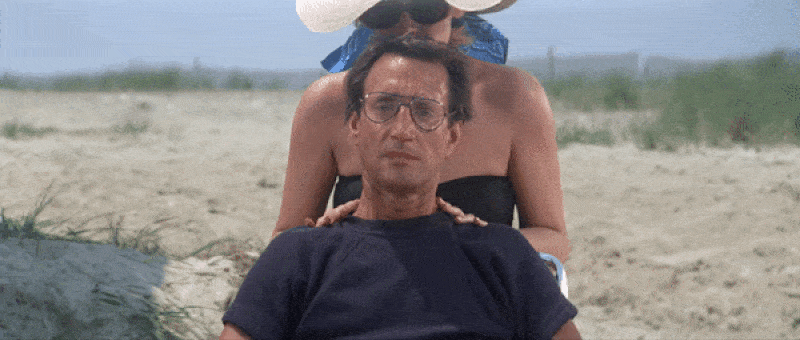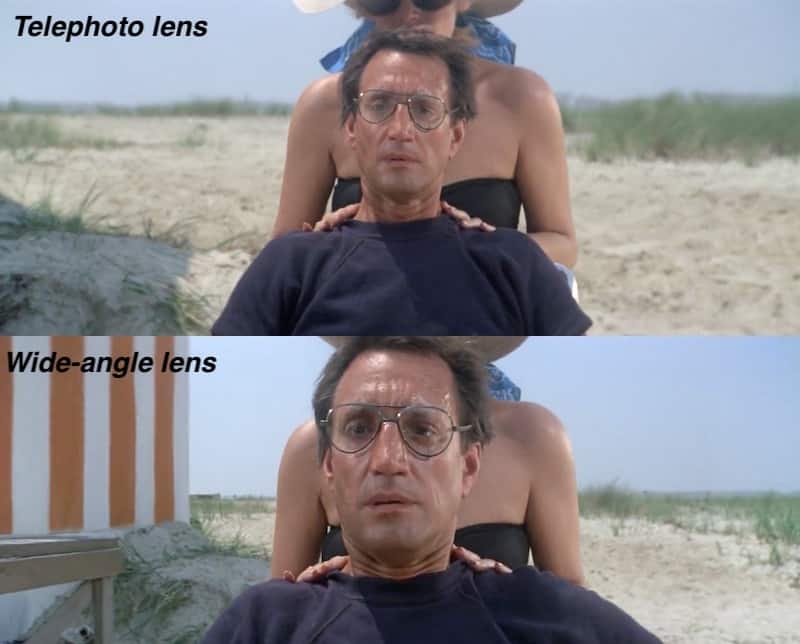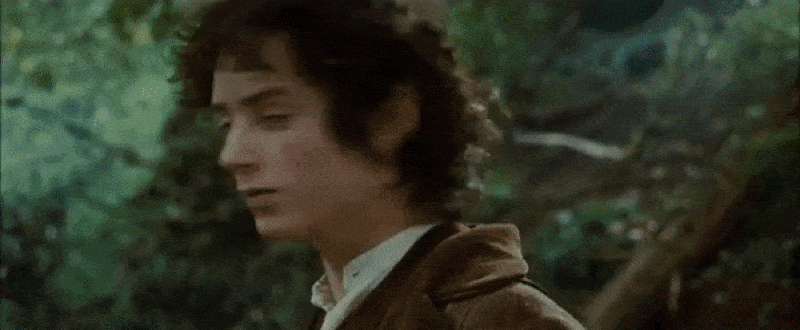Welcome to How’d They Do That? — a bi-monthly column that unpacks moments of movie magic and celebrates the technical wizards who pulled them off. This entry explains the in-camera effect known as the “dolly zoom.”
Even if you’re unfamiliar with its name or how it works, if you’re a fan of movies, you’ve likely seen a dolly zoom. And if you’ve seen a dolly zoom, you know that its power cannot be denied.
Dolly zooms are an overwhelming and unforgettable effect. If you’ve ever seen a shot where a background warps impossibly, expanding or constricting around a character, you’ve seen a dolly zoom. If you’ve ever seen a shot with a sudden distortion of perspective that zeroes in on the subject, you’ve seen a dolly zoom. And if you’ve ever seen Jaws, you’ve seen a dolly zoom.

In all their boldness, dolly zooms can achieve some of cinema’s most powerful moments of visual storytelling.
They can create a sudden sense of unease and disorientation. They can signal powerful and uncanny emotional states such as tension, epiphany, euphoria, and dread. They can make it feel like the floor is dropping out from under you or that the walls are closing in. They can shrink distance or send the background barrelling off into the unknown. When deployed with purpose, like the best effects, they are so much more than a visual flourish.
Employed brazenly, dolly zooms can have a positively brain-breaking effect. And after you scrape your flabbergasted grey matter off the floor, you might find yourself asking: why did that look so strange? How did they manipulate space like that? Did the filmmakers use a green screen? Was it rear projection? What is going on here, exactly?
How’d they do that?
Long story short:
Dolly zooms are an in-camera illusion achieved by combining a wide-angle zoom lens, a steady zoom, and a dolly. By dollying and zooming in opposite directions, the foreground elements appear to stay the same size while the background appears to squeeze or stretch.
Long story long:
Before we begin, I want you to humor me and imagine that you’re looking down a hallway at a window. The further away you stand from the window, the less of the outside world will be visible to you. Now, two things:
- From this far-off position, if you were to take out a camera and zoom-in on the window, it would appear bigger. But the amount of what you could see outside of it would remain the same.
- Again, from this distance, if you were to physically approach the window (imitating a dolly-in), the closer you got, the more of the outside world you’d be able to see.
That was a very basic exercise. But these are the fundamental principles of the dolly and the zoom. And we need to understand them in order to understand how the dolly zoom works. Also, before we continue, I’m assuming most folks are familiar with what a “zoom” is. But the same might not be true for dolly shots. Dolly shots refer to a shot captured by a camera mounted on a wheeled cart, which is usually on tracks. The two dolly moves that concern us are when the camera moves towards (dolly-in) and away from (dolly-out) the subject. To put it differently: zooms magnify, dolly shots move.
Now to recap: if in our imaginary hallway you were to dolly-out or zoom-out to the same spot and look in your viewfinder, you would see an identical image. If you were to zoom-in from this position, the subject (a.k.a. the window), would appear magnified. If you were to dolly-in instead, you would create a visual phenomenon known as “perspective distortion.” Perspective distortion is the apparent spatial warping of an object and its surrounding area due to the relative scale of nearby and distant features. In other words, it is the phenomenon of objects looking different when a camera’s relative distance to them changes.
The dolly zoom combines all of these basic principles with trippy results. To get into the nitty-gritty of how it does this, we need to unpack the two traditional types: (1) dolly-out and zoom-in and (2) dolly-in and zoom-out.
In both types, the camera focuses on a single point in space (usually the subject). The zoom works to keep the frame crop relatively consistent. And the opposing dolly/zoom techniques nullify the focal point’s visual movement. This keeps the foreground elements roughly the same size throughout the shot. Meanwhile, everything that isn’t the focal point distorts as the perspective continuously changes. This creates the effect we associate with the dolly zoom.
Broadly speaking, dolly zooms look weird because they are, quite literally, breaking our brains. The human visual system uses size and perspective cues to determine the relative size of objects. So seeing a perspective change without a size change is naturally unsettling.
To get more specific, how the distortion looks and feels depends on which dolly zoom you use. If the camera dollys-out and zooms-in, the longer focal length creates a heightened magnification and a narrower angle of view, flattening the image. This makes it appear as though the background is closing in around the foreground subjects. That’s what’s happening in this diner scene in Goodfellas and this anxiety attack in La Haine:
If the camera dollys-in and zooms-out the focal length shortens creating a lower magnification and a wider angle of view, curving the image. This gives the appearance of the background expanding around the subject. That’s what’s happening in this shot from Poltergeist and this shot from Jaws:
Dolly zooms can also be a helpful way of seeing the difference between a telephoto lens and a wide-angle lens. Let’s go back to that dolly zoom from Jaws and compare how it starts with how it ends. When the shot begins, the subject (Roy Scheider‘s Brody) is far away from the camera. We can see less of the background because the lens is focused on a smaller portion of what’s in front of it. Then, when the camera pushes forward while zooming out, the focal length changes. This causes Brody’s face to stretch unnaturally while more of the background becomes observable to us. This is, effectively, a shift between a telephoto lens and a wide-angle lens. And the change from one to another makes an emotional point. In this case: a horrific, stomach-turning realization that an enormous shark is chowing down on a child.

The difference between the two types of dolly zooms (expansion or contraction) produces very different emotional responses for the viewer. The contraction effect closes the world around the subject evoking paranoia and impending danger. You can see this at work when Frodo first senses the Nazgûl in The Lord of the Rings: The Fellowship of the Ring. By shrinking the distance of the road, the camera implies that this enemy is fast-approaching and that even woods have recoiled in its presence.

When you do the opposite move (dolly-in, zoom-out), the world pushes away from the subject. This expands space and can create a domineering sense of isolation and panic. If you’re watching a scene where a hallway extends impossibly (as in Poltergeist) you’re most likely looking at a dolly-in, zoom-out.
In the end, three factors contribute to the dolly zoom effect: (1) the direction of the camera’s movement; (2) the speed with which you dolly; and (3) the focal length of the camera’s lens. Ultimately, how filmmakers modulate these factors has a considerable effect on how the shot feels.

What’s the precedent?
In order for a dolly zoom to work correctly, cinematographers require a smooth dolly track and a steady zoom lens that can be controlled reliably and precisely. A key reason for this is that the speed of the dolly and the zoom need to match in order for them to land at the same time. Suffice to say: to make a cinematic dolly zoom you need the right equipment. This is the reason it took so long to “invent” the effect in the first place. Pulling them off is actually rather tricky.
It is generally accepted that the dolly zoom first appeared in a mainstream motion picture in 1958, with Alfred Hitchcock‘s thriller Vertigo. In fact, many people know them as the Vertigo Effect. (The list of pseudonyms is actually very long, and includes the trombone shot, the push-pull, and contra-zoom telescoping). In Vertigo, Hitchcock deploys dolly zooms several times to convey John “Scottie” Ferguson’s (Jimmy Stewart) agoraphobia and, well…vertigo. The dolly zoom conveys his sense of nausea, imbalance, panic, and skewed proportion. It’s perfect.
Most people agree that Vertigo put the dolly zoom on the map. But there are some who say that it was the first film to implement the technique full-stop. According to legend, Hitchcock got the idea for the shot after he got lightheaded at a party and fainted. Supposedly, this idea percolated as far back as Rebecca. And as the story goes, Hitchcock approached Vertigo‘s second unit camera operator, Irmin Roberts, who developed the shot.
Whether the myth itself is true or not, the fact remains that the effect’s presence in Vertigo represents the culmination of smoother zoom lens technology as well as a narrative need. And if having an effect named after your film isn’t grounds enough to claim precedent, I don’t know what is.

0 comments:
Post a Comment